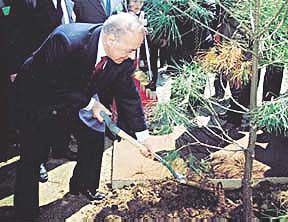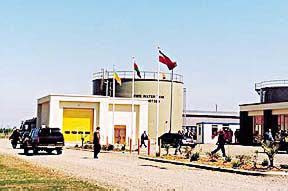|
Summer
1999 (7.2) AIOC:
President Aliyev planting a tree in the Supsa terminal area on April 17, 1999 when the new oil terminal at Supsa, Georgia, on the Black Sea (below) was dedicated. This is the terminal point for the Western Route Export Pipeline (WREP) for Azerbaijan's oil from the Caspian. This concludes the second pipeline route for Azerbaijan's oil. The first oil tanker was loaded up earlier in April. The WREP was completed within less than three years since the April 1996 signing of Azerbaijan and Georgia's intergovernmental agreement on transportation of Azerbaijan's oil through the territory of Georgia. During peak production, the project employed about 4,000 people, of which 70 percent were Azerbaijanis and Georgians. David Woodward, President of AIOC, said that the completion marked "the engineering triumph of those who designed and built this new oil pipeline system within the space of 30 months. They had to meet the challenges of distance, terrain and logistics while taking great care for the environment and safety of personnel. But something more than great engineering expertise was necessary to deliver this success-to open a new route for Caspian oil to world markets. The vision and drive of two nations-Azerbaijan and Georgia-were essential in ensuring that the Western Export Route was completed on schedule and is transporting oil today. . . "This is not the finale," Woodward continued. "Those who operate the pipeline will continue to work in this cooperative and successful manner to build a reputation for operating excellence and bring continuing economic benefits to Azerbaijan, Georgia and the foreign oil companies. The success of the Western Export route should be an example to other international investors, who surely then will be keen to build upon our success and invest to bring further prosperity and opportunities to the people of these two nations." Performance Update AIOC's Chirag production plans for 1999 stipulate more than doubling last year's production to reach more than 5 million tons of crude oil this year. At present, AIOC is on course to achieve this goal. The total production to date from Chirag since November 1997 is over 4 million tons, with a daily production of 100,000 barrels. Of that amount, AIOC is pumping about 85,000 barrels per day (bpd) into the WREP. The plan is to achieve a 100,000 bpd target daily. Production in 1999 through early May has been 1.6 million tons. AIOC's recent drilling operations have been very successful. AIOC is scheduled to drill its 12th well at the Chirag platform in the near future. In all operations, the highest standard of safety and environmental performance remains the top priority. Full Field Development Full Field Development of AIOC's Contract Area is the scheme that will ultimately result in the complete development of the Azeri, Chirag and Gunashli field with a maximum oil production rate of 800,000-1,000,000 barrels per day. AIOC's project team, SOCAR and design engineers from Brown and Root are currently working on a design concept for the first phase of Full Field Development, which concentrates on the Azeri field and will achieve production of 250,000-300,000 bpd. The concept comprises a drilling and accommodation platform with process facilities, a new 30-foot subsea oil pipeline to Sangachal, conversion to gas export of the existing 24-foot subsea oil pipeline from Chirag to Sangachal and expansion of the Sangachal terminal. The projected cost is $1.6-2.1 billion. Main Export Pipeline The Azerbaijan Working Group for the Main Export Pipeline (MEP) includes three SOCAR and three AIOC representatives with Azerbaijan's Deputy Prime Minister Abid Sharifov serving as Chair. This committee is negotiating with the relevant transit countries and is expected to deliver a recommendation to Azerbaijan's government this year. Negotiations are currently underway in regard to Turkey. Once a conclusion has been reached, negotiations will take place in Georgia and Russia. Negotiations with Turkey include construction of a pipeline between the Baku-Jeyhan (port on Turkey's southern Mediterranean coast) for a "lump sum" price with a Turkish government completion guarantee. The MEP will be a regional pipeline used by Azerbaijan and other Caspian oil producers for export of crude oil to world markets. The throughput capacity will be 50 million tons per year. Public Awareness  AIOC
has been conducting Public Awareness Program meetings in the
district of Shamkir this past April. AIOC also has a pumping
station and a radio AIOC
has been conducting Public Awareness Program meetings in the
district of Shamkir this past April. AIOC also has a pumping
station and a radio communication station in this area. A group of AIOC representatives, including experts from oil transportation, pipeline operations, public relations and safety and environmental departments, met with the district communities in order to build relationships that would raise public awareness and facilitate a better understanding of AIOC's export pipeline operations there. Children from refuge families receive gifts through AIOC's Community Program. The group will continue to work closely with various communities in the district to ensure cooperation and support of residents from schoolchildren to authorities. AIOC recognizes that improved education of young citizens of Azerbaijan is critical to their own and the nation's future and is planning to carry out a number of educational programs in villages and residential areas close to its facilities in Shamkir. Humay Prize AIOC received its second Humay prize. This time it was for AIOC's contribution in 1998 to the development of Azerbaijan as a newly independent nation. Crawford Gordon, AIOC's Government and Public Affairs Director received the prize on behalf of AIOC. He noted that AIOC is a young organization [since 1995] and that it is involved with developing skills of a large number of Azerbaijanis. Their development along with AIOC's success can help develop this new nation. Humay is one of the most significant annual cultural events in Azerbaijan. AIOC has been one of the sponsors of the Humay Prize Presentation ceremony for the past four years. The ceremony is held each spring to recognize the best creative and professional achievements in arts, literature and culture in general. AIOC was awarded its first Humay Prize and Honorary Diploma in 1996. Tamam Bayatly
is Media and Government Affairs Specialist at AIOC. Back to Index
AI 7.2 (Summer 99) |



